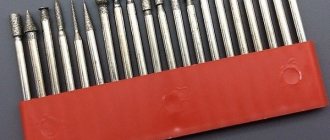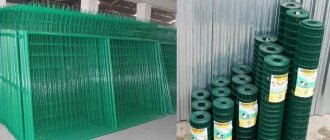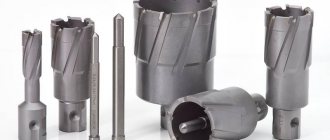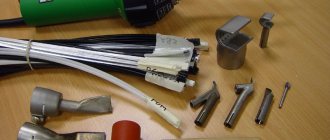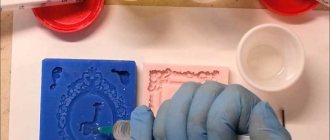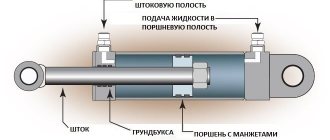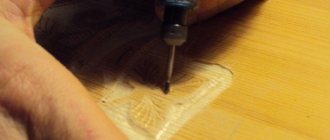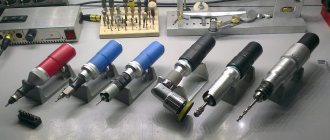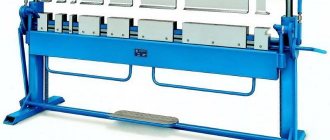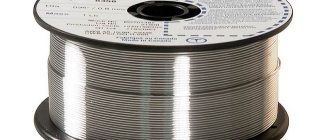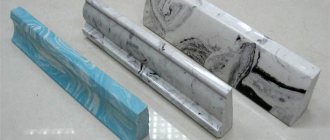SHARE ON SOCIAL NETWORKS
FacebookTwitterOkGoogle+PinterestVk
Drill attachments have turned this tool into a universal assistant. Thanks to these removable devices, you can not only make holes, but also cut building materials, mix mixtures evenly, and also treat the surfaces of products made of plastic, wood, metal and concrete. This article describes the main types of nozzles, their characteristics and scope of application.
Thanks to a variety of attachments, the drill turns into a universal tool
Types of nozzles
Grinding attachments for drills differ in shape and material, but they all have a common part - this is a cylindrical rod that is clamped into a chuck. An abrasive or grinding material is attached to the rod in one way or another.
The most common grinding attachments for drills are:
- End - in the form of cylinders, cones and other figures of rotation made of hard abrasive.
- Cup brush or soft, cup-shaped material.
- Plates - made of plastic or rubber with a fixed piece of sandpaper.
- Disc - metal or soft.
- Fan-shaped with strips of sandpaper fixed in the shape of a fan.
- Soft in the form of discs for polishing.
- Drums with sandpaper.
Cup attachment
There are other designs of grinding attachments for drills, some are designed specifically for grinding the surface of parts with particularly complex shapes.
Angular attachments for drills stand apart. They do not have a working element, but serve to change the plane of rotation of the shaft, by 90° or by an arbitrary angle from 0 to 90°. At its end there is another cartridge into which the usual nozzle is clamped. This device allows you to work in hard-to-reach places. When installing an angle attachment on a drill, it is important to carefully check its attachment to avoid personal injury and damage to equipment and materials.
Wood processing equipment
On the modern market there are drilling devices that make it possible not only to reduce the depth of holes and control the vertical location of their axis, but also to use the drill bit as a small cutter. Such devices are especially well known among home professionals who make their own furniture.
When using different working tools on wood, different technological procedures can be carried out (in particular, milling, side drilling of holes in products with a convex or more complex configuration that require the use of special inserts). In some milling modifications of such flexible devices, special suction pumps are connected, combined with a vacuum cleaner, with the help of which dust and small chips are removed from the processing area. It must be borne in mind that even such multifunctional devices do not make it possible to turn the drill into a full-fledged hand-held cutter.
It has:
- the same work opportunities;
- guarantees higher reliability and quality of processing.
No one will deny the fact that it is much more comfortable to use a drilling mechanism to create holes (the processing accuracy is higher with the equipment). Most of the modern modifications of this adaptation are equipped with a vice for fixing the element during processing, as well as a frame in which such an element can move freely.
The tool itself is located in a special drill holder (basket), which is a multi-purpose clamping device and can be used for virtually any modification of the drilling device. Such a device, the shield of which uses a clear metric grid, seems to be a very necessary acquisition for every home craftsman, since it makes it possible to form holes with minimal cost and accuracy.
Advantages and weaknesses
The main advantage of the device is to expand the functionality of an already purchased tool. Additional surface finishing capabilities do not require the purchase of expensive specialized equipment.
Advantages of a drill attachment compared to specialized equipment:
- high-quality grinding of hard-to-reach places;
- ease of working with small parts;
- cost savings;
- opportunity to do it yourself.
But there are also disadvantages:
- not as convenient to work as with a special tool;
- for high-quality grinding you need to acquire the skill;
- lower productivity;
- Rotation speed adjustment is often required.
If the amount of work is small, then the advantages far outweigh their disadvantages.
An old hand drill - what you can do with it yourself
The hand drill is a trouble-free drilling tool that was extremely popular half a century ago. As soon as electric drills appeared, the demand for hand-held devices decreased, but did not disappear completely.
Today, this tool is probably gathering dust in the garage, and everyone wonders what can be done with an old hand drill. You can try to sell the tool, but don’t rush, you will be able to get no more than 100 rubles for this tool, but by making useful homemade products, you will get a unique unit.
Let us consider in detail what can be made from the tool in question.
Interesting facts about hand drill
Since its invention, the tool in question has been actively used for drilling wooden and metal structures, but such a device is not intended for drilling concrete.
This is due to the fact that the device does not have a shock function, so it is almost impossible to drill a hole in concrete with such a tool. However, home craftsmen found a way out of the situation.
While drilling concrete, periodic hammer blows were applied to the heel, which allowed the drill to advance into the material.
The main drawback of the tool is known to everyone who has ever used it. It involves the need for physical effort. If drilling wood required little effort, when working with metal and concrete, it took at least several hours to achieve results.
The operating principle of the tool in question is simple, and consists of transmitting rotational manipulations from the handle to the tool chuck through a pair of gear drives.
Gears help increase the rotation speed of the chuck, but at the same time reduce the torque. The simple and uncomplicated design makes the tool in question not only repairable, but also durable.
All that is needed to extend the service life is to monitor the amount of lubricant on the gears of the tool.
So, if you remember the design of the hand drill mechanism, as well as what it is, then it’s time to figure out what can be made from this tool.
Device for tightening and unscrewing long screws
To unscrew or screw a long self-tapping screw into wood, you will need to put in a lot of effort. If you've tried doing this with a screwdriver or electric drill, you know that it's quite difficult to do.
The self-tapping screw will “go” into the wood to a certain depth, but it is almost impossible to tighten it completely with electric tools.
It is also extremely difficult to do this manually, so you should call an old hand drill for help.
The tool for screwing or unscrewing long screws does not need to be modified. You just need to clamp a bit in the collet chuck of the device of the appropriate size and get to work. The efficiency of using hand tools when screwing long self-tapping screws is an order of magnitude higher compared to low-power screwdrivers and high-speed electric drills.
!Achieving the result depends on the correct choice of bit for the head of the screw being screwed in.
Making a screwdriver attachment from a hand drill
Few people know what can be done from an old drill, so don't be in a rush to recycle or sell this invaluable tool.
From it you can make a device for a screwdriver, which is designed for screwing and unscrewing various fasteners. These can be not only long self-tapping screws, but also bolts and nuts.
The secret of this device is that you can make a very useful thing out of an old drill, which will allow you to get to hard-to-reach places and then unscrew the fasteners.
The principle of making an attachment or device for a screwdriver from a hand drill is to perform the following manipulations:
- First, we free the tool from unnecessary parts. To do this, remove the chuck from the tool, as well as the handle.
- The thrust heel is also dismantled, which will not be needed in the new device.
- The shaft on which the cartridge was located has a fairly large diameter. It will not be possible to install a shaft of this diameter into a screwdriver chuck, so let’s start grinding it down
- It is recommended to grind the shaft to reduce its diameter on a lathe. The use of an emery wheel or grinder for such purposes is not recommended, since the grinding will be uneven
- To grind a shaft on a lathe, it will first need to be removed from the tool. It's not difficult to do this. In the mechanism, near the bevel gear, which is mounted on the shaft, there is a hole with a cotter pin. This cotter pin must be knocked out, thereby disconnecting the gear from the shaft
- After grinding the shaft down to 8-10 mm on a lathe, it should be installed in place, not forgetting to pin it. The shaft is made of hardened steel, so before grinding it, it is recommended to do heat treatment (heat it with a blowtorch)
- The shaft is driven by a ball bearing, which can be lubricated to extend its life.
- The first part of the work is completed. The shaft that was ground off will be used as a transmission device on the new device. The working element on the device will be the shaft on which the handle is attached
- The second shaft has a specific hexagonal shape, which should also be machined so that socket heads or other attachments can be put on it. The simplest option is to make a square shape from the hexagonal shape of the end protrusion for securing the heads
- This can be done using a grinder and a cutting wheel. In this case, only heads for screwing and unscrewing bolted connections can be installed on such a shaft
- If you plan to use the device for other purposes, then threads can be cut on the shaft by first making it cylindrical and grinding it to the required size
- A drill chuck must be screwed onto the cut thread, into which you can install various attachments - bits, mixers, drills, cutters, etc.
- Please also note that to install the chuck on the secondary shaft of the device, you will also need to cut an internal thread for control fastening of the collet chuck
- To complete the manufacture of the device from an old hand drill, it is necessary to cut off the remaining part on which the thrust foot was attached
- After this, the homemade device is ready for use. All that remains is to fix it in the screwdriver chuck and test it
The advantage of such a device is that it increases the torque. The screwdriver drives a small diameter gear, which transmits force to the larger gear.
A small gear is attached to the large gear, and the force is transmitted to the second large gear, on which the secondary shaft is located, thereby reducing the rotation speed, which means increasing the torque. As a result, the device allows you to unscrew and tear off stuck and rusted bolted connections.
However, do not forget that the main role is played by the screwdriver, which must have the necessary power reserve, otherwise its engine may suffer.
What are the advantages of using an old drill attachment for a screwdriver?
Having figured out what can be done from an outdated hand drill, you need to find out the advantages of this device. These advantages include:
- Torque increases 6-7 times. This means that the force from the screwdriver increases by so many times
- Ability to access bolts and nuts that are in hard-to-reach places
- To make the device, you will not need additional materials, since everything can be done with your own hands.
- No need to purchase additional consumables
In addition to the fact that the device can be used for screwing and unscrewing fasteners and large screws, the device also allows you to quickly tighten and unscrew them. You will definitely be satisfied with this device. How to make it is shown in detail in the video instructions below.
What else can be made from an old hand drill - a quick-driver
The above describes the process of making a homemade product from an old two-speed drill, which has 4 gears. However, there are also single-speed devices that can also be used to make homemade products.
This type of tool can be used to make a screwdriver that can be operated with one hand. This is very convenient when the other hand is busy.
This device is called a quick-twist, and the principle of its manufacture is as follows:
- Take an old clamp or weld a U-shaped frame on which the homemade components will be located
- On one side, weld a fixed handle, as well as a movable trigger (made of steel with a thickness of at least 1.5 mm), which is connected to ¼-1/5 of the bevel gear from the tool
- On the other side of the U-shaped frame, a shaft is attached, on which a cartridge and a bevel gear are fixed, connected to the half-gear from the trigger
- When you press the handle, the cartridge moves due to the transmission of torque
- A bit of the appropriate type is fixed into the chuck, after which you can start working
This homemade product has one drawback - it is necessary to disconnect the bit from the fastening element in order to return the handle to its original position. An example of such an invention is shown in the photo below.
Making a machine for winding coils from a drill
What else can be made from an old hand drill that has been gathering dust in the garage for more than 10 years? Of course, you can make a simple device that will allow you to wind coils. You can wind not only threads and ropes, but also wire, for example, when rewinding electric motors.
The design of such a machine is very simple, and to manufacture it you will need to use the following devices:
- Vice - a fixed handle or tool stop located in a horizontal position is attached to them
- A block of wood of the appropriate size, which is located near the cartridge. This block acts as a stop, holding the tool in a horizontal position
- A reel or other devices are attached to the tool chuck, onto which material is wound - wire, rope, threads, etc.
A photo of such a device is shown in the photo below. If you attach a sharpening wheel to the chuck, the tool can be used as a hand sharpener.
Drilling machine from hand drill
To prevent the old drill from sitting on a shelf in the garage, it is proposed to make a manual drilling machine from it.
The advantage of such a tool is that you can always carefully make a hole in wood, glass, plastic, metal and even ceramic tiles using the appropriate types of drills.
The manufacturing principle is simple, and lies in the fact that you first need to make a frame with a movable frame on which the hand tool will be installed.
- For manufacturing you will need a board, metal corners and cylindrical guides, for example, studs, on which you need to grind off the threads. The length of the pins affects the amount of tool movement
- First, a base is made to which pins are attached, located straight on one side of the wooden frame
- Holes are drilled in the corners for the studs
- These corners with holes are put on studs
- A wooden board of the appropriate size is attached to the corners, which will serve as the basis for securing the tool
- The drill is installed and secured to the moving part
- To ensure smooth movement of the bed, a latch is made that acts on the pin, thereby limiting the movement of the movable bed
The design of the device can be different, and it all depends on your own ingenuity, but the principle of creating such an invention with your own hands is shown in the photo below.
Making a ratchet from an old hand drill
The range of tool capabilities does not end there. You can also make a convenient ratchet wrench from an old and unnecessary hand drill. Moreover, it can be used as a regular wrench, that is, tightened by hand, or in tandem with a screwdriver.
To make the tool, you will need two bevel gears and a drill shaft, as well as steel tubes, plates and a welding machine. The process of making the tool is shown in detail in the video material. The result is a universal hand tool that is definitely stronger than modern ratchet wrenches.
As you can see, a hand drill is a very interesting tool from which you can make various homemade products, expanding your capabilities and also simplifying your work. If you come up with something else that can be done with a hand drill, be sure to share it, as it will help people use an outdated tool to do new things.
How to use attachments
The main areas of application for drill attachments are as follows:
- cleaning surfaces from rust, old paint residues and other contaminants before painting;
- polishing metal surfaces;
- polishing paint and varnish coatings;
- polishing glass or plastic (for example, car headlights);
- glass edge grinding;
- cleaning of metal parts after welding;
- grinding surfaces in hard-to-reach places.
Polishing the surface using a nozzle
In addition to grinding, special devices are also used for cutting thin sheets of metal and for plucking bird feathers.
Types of materials for making nozzles
Materials for the working body vary greatly in softness, elasticity and abrasive grain size. The main ones are:
- Sandpaper. They vary greatly in hardness, graininess and water resistance.
- Soft materials. Serve for polishing and fine finishing.
- Grinding stones. For rough surface treatment and correction of defects.
Grinding stone
The variety of materials and shapes of devices allows you to choose the most suitable one for each specific operation. Thus, a drill attachment coated with diamond powder will allow you to polish surfaces made of the hardest materials, and miniature attachments are suitable for finishing jewelry.
Tips for use
Do you use drill attachments?
Constantly! I want to try
Different materials and tip types require specific grinding speeds. It corresponds to the number of revolutions of the tool. Therefore, for efficient operation, you should choose a drill with a wide range of motor speeds.
The simple structure of many equipment elements allows you to make them yourself. This is especially true for drum and soft tips, as well as disc models with attached sanding sheets.
For the convenience of performing tasks, you can also create a special holder that fixes the drilling unit parallel to the table, which will allow you to use it as a machine for sharpening and grinding.
A large assortment of various accessories for drills helps you save on the purchase of expensive devices that perform similar functions. This allows you to perform a wide range of tasks at home using one device.
Cutting attachments
Special drill attachments for cutting thin sheet metal, unlike the widely used grinder, make a more accurate cut and practically do not deform the sheet coating. This is especially important when cutting profile sheets for a fence or metal tiles for a roof. In addition, the device allows you to rotate the cutting line at large angles and along a minimum radius, which is simply irreplaceable when constructing a roof of complex shape.
The device is installed on a drill chuck and is driven by the working shaft. To ensure reliable operation of such a device, the rotation speed of the chuck should be from 2800 rpm, power - from 400 watts.
Drill attachments for cutting
Special attachments for cutting metal have the following advantages:
- smooth cutting line, without burrs and notches;
- any configuration of the cut out piece of sheet;
- does not damage the anti-corrosion coating of the sheet;
- ease of use.
Cutting devices can handle ferrous metal up to 1.5 mm thick, non-ferrous metals and plastic up to 2 mm thick.
Other attachments
- There is an angled attachment for a drill, with which you can make holes in places where it is not possible to work in the usual mode. The angle can be adjusted, or it can be constant - 90 degrees. Using hole saws, you can drill holes in concrete, wood, tiles or ceramic tiles, as well as in metal and other large materials. The device is made of high-quality steel so that the hole stops smooth and does not have any cracks or chips after processing.
- There are also accessories that are designed to sharpen drills. This is a kind of body with a leash and a sharpening stone, which is located inside. The holes for sharpening drills have different diameters. Their number can reach 15 pieces.
- Mixer attachments are used to mix different solutions, paints or other necessary mixtures. It is necessary to select a device depending on the consistency of the liquid.
- To tighten a self-tapping screw or screw, you can buy a special attachment, but it is advisable to use it only on those drills that are equipped with a low-speed function.
- If there is poultry on the property, you can buy a plucking attachment. This equipment will instantly remove absolutely all feathers from the carcass. A positive feature is that the meat and skin will not be damaged at all. Before starting work, you don’t even need to scald the bird first, and after work there is no need to treat it with a blowtorch. This equipment is very easy to use; you just need to attach it to a drill and bring it to the carcass. The device is made of lightweight materials that take up very little space.
- If you are working with wood materials, then various types of cutter attachments are specially sold for this purpose. With their help, a part can be made into various shapes, holes can be machined, and defects can be removed.
Before you start working with any attachment, you need to make sure that it is securely fastened; you should always hold the drill with only two hands. You should also wear glasses while working to avoid damaging your eyes.
As you can see, devices are made for absolutely any purpose, and it is not at all necessary to buy expensive and massive equipment, since everything can be done with just one drill. Explore all the options for attachments and choose exactly the one you need to perform a specific job.
Sanding and polishing attachments
Drill attachments for grinding and polishing allow you to perform a wide range of jobs. The main ones are:
- cleaning parts before painting or welding;
- grinding and leveling surfaces;
- final finishing and polishing of surfaces made of metal, wood, plastic or glass, as well as paint and varnish coatings;
- processing the glass edge after cutting.
They allow you to avoid purchasing expensive specialized equipment. It is worth remembering that with a large volume of work, the drill will not be able to provide the required level of performance and will wear out quickly, since it is not designed for constant loads perpendicular to the axis of the working shaft.
Drill attachments for grinding and polishing
Devices for grinding and polishing differ not only in the shape of the working body, but also in the degree of rigidity of its material by:
- hard;
- soft;
- super soft;
- embossed.
It is impossible to complete the grinding and polishing operation from start to finish with just one device. Your home workshop should have a set of such devices.
Polishing attachments for screwdrivers: purpose, selection and operation
The modern equipment market offers a wide variety of tools to perform almost any job in the comfort of your home. This approach helps to save significant money and not doubt the quality of the result. Such work includes grinding and polishing of any materials.
Sanding is necessary to make the surface smooth or prepare it for painting. This is the process of removing small irregularities from any surface. Polishing in simple words can be described as the process of rubbing a surface to a shine.
At home, such work is most often carried out when processing metal, in particular, a car body for painting. In this case, sanding precedes the application of a layer of paint to the metal, and polishing allows you to see the result in the best possible light.
However, there are other types of work:
- cleaning metal from corrosion;
- descaling;
- removal of old coating;
- removal of sagging (in concrete).
To perform such work, you need not only a polishing or grinding wheel with various attachments, but also a drill or screwdriver. Preference is often given to the latter, since the tool has more compact and convenient dimensions, as well as the ability to charge from batteries.
This option allows you to perform the necessary work outdoors without worrying about the lack of outlets. Having dealt with the tools, you can move on to considering the types of attachments for it.
Regardless of the type of material being processed, attachments perform 3 main functions: stripping, grinding and polishing.
These operations can be performed with the following materials:
- tree;
- concrete;
- ceramics;
- granite;
- glass;
- metal.
Types of nozzles also differ in quality and price. These criteria depend entirely on the manufacturer. The more famous the brand purchased, the higher the price, and usually the better the quality. Well-known manufacturers try not to spoil their good reputation by reducing the cost of production in favor of short-term profits.
Screwdriver attachments are distinguished by the type of material to be worked with and the type of coating of the device itself.
Nozzles are divided into:
- plate;
- cup;
- disk;
- cylindrical;
- fan;
- soft (can have different shapes);
- end
Plate attachments can be called universal. They are attached to the cartridge using a special small metal pin located in the middle of the circle. They produce fixed and adjustable products.
The upper part of such a device is covered with Velcro, so special wheels of sandpaper with different grain sizes can be easily changed. This is the main advantage of this attachment, since there is no need to buy a more expensive product.
You just need to buy a set of sandpaper you need.
Cup attachments are also often used when working with various materials.
They are a plastic recessed round base, on which pieces of wire of the same length are attached along the perimeter in several rows.
This device is very similar in appearance to a cup, which is why it got its name. This attachment is used for rough grinding work.
Disc attachments for grinding are derivatives of cup attachments, with the only difference being that in this type there is no cavity in the middle, and the disc on which the wire is attached is metal. The wires in such a product are directed from the center of the device to the edges, which makes the nozzle flatter. It is great for sanding areas with a small access perimeter.
Cylindrical products have a shape very similar to a drum, onto the ends of which tape sandpaper is attached. The body itself can be made not only of hard material, but also of soft one. The fastenings of the abrasive belt are also different.
It can be fixed using the maximum expansion of the nozzle itself or by bolt connections, which, when tightened, create the necessary tension. Such devices are intended to work inside hollow products such as the inside of pipes.
These attachments also perform well when processing the edges of glass sheets.
Fan products are disposable, as they initially consist of sheets of sandpaper attached to a disk. They are designed primarily for work in the interior of small recesses and pipes.
Such a nozzle is expensive compared to simple abrasive paper, but often it is impossible to grind with other devices.
Therefore, it is advisable to have this type in your home set in several variations: with larger and smaller crumbs.
Cup
In a cup nozzle, the working body has the shape of a bowl, on which more or less rigid bristles made of wire or plastic are attached. It is used for cleaning surfaces from rust, solid contaminants, welding slag and remnants of old paintwork.
Cup attachments for drill
There are also soft cup attachments with a working body covered with felt or foam rubber. They are used for polishing painted surfaces.
Using it requires developing a certain skill - when the axis of rotation deviates from the vertical or when the drill is held weakly, the cup has a tendency to move to the side, which can lead to damage to the polished surface or grinding of areas not intended for processing.
Disc and plate
Disc grinding attachments are similar in design to cup ones, but the wire or plastic bristles in them are directed not forward, but to the sides, in a plane perpendicular to the direction of rotation of the shaft. They must be used with caution, as they can damage the sanded coating.
Disc attachment
The plates consist of an elastic plate, to which it is attached with glue, double-sided tape, Velcro (Velcro), or a circle of sandpaper is clamped in the center. The edge of the plate can be curved, which allows you to bring the sandpaper to the surface at different angles and process hard-to-reach places.
Disc ones allow, among other things, the use of abrasive and cutting discs from angle grinders (grinders). They are attached to the shaft through a centering adapter.
In order not to damage small parts, it is better to secure the drill in the machine and bring the part to the disk, holding it with your hands or clamping pliers.
Homemade accessories for drills with your own hands
For household repairs and work on a summer cottage, various power tools are used. Specialized additional instruments and devices are produced for them, many of which can be made with your own hands.
It is better to get complex industrial devices ready-made, but workbenches, tables, attachments and almost everything else can be made without the help of others. Handmade devices for power tools can be adjusted to the required technical conditions.
Classification of devices for power tools
Do-it-yourself power tool accessories are usually systematized into the following categories:
- Tools and attachments for processing. These are hand-held devices, which include grinding attachments and bars for grinders and drills.
- Devices for modifying the position, mounting a certain cutting angle, drilling and the rest. These are the main surfaces, standards, guides. They can have different external types, often made of metal or wood.
- Dust removal devices. Similar devices are used to remove sawdust, dust, and shavings from the working plane. It is not so difficult to make such devices with your own hands; as a rule, pre-existing fan holes in the equipment are used for mounting.
- You assemble grinding attachments, structures or bars designed for surface treatment with your own hands. For example, to polish a wooden surface or clean an alloy, you can use a wooden plate with a handle on top. Sandpaper of the required grain size is fixed on its working side. The platform model can be anything, it is only important to choose the right abrasive material.
Diagram of the milling table device
Attachments for power tools vary, but sometimes they are large scale, as is the case with milling machines and saws.
It is recommended to choose an improved table that will contain everything you need without exception for comfortable and non-hazardous work. The most common type is a milling table, made in the form of a large board with an opening for a router and a guide board.
The scale of the worktop can be different, everything without exception depends on what kind of work will be carried out. The most ideal type is a table with legs of the required height. And the working and guide boards are made from chipboard sheets. In this case, vices and clamps can be taken into account on the surface.
It is generally better to make table legs replaceable and provide a backup set.
Workbenches for power tools
To work with numerous devices, you will need to improve your workplace. For a home workshop or a car garage, a small, compact and universal workbench may be necessary.
It is not so difficult to make it without the help of others; you just need to specifically improve your choice of what functions it is needed for.
In general, it is more correct to make a workbench that can be used at any height, including on a table.
Then it will be possible to position the power tool comfortably and change its position if necessary.
For work, it is recommended to use various hard woods; a common material is maple, which is easy to process and yet has the required hardness and strength.
To register on the table, it is possible to attach comfortable legs or clamps to the installation. A workbench requires a vice; they are often used in work, which guarantees an improvement in its quality.
Drill attachments
During operation, the drill may need various attachments. They make it possible to simplify work, make it simpler, more comfortable, and faster. A huge number of homemade products are used for the drill, which numerous manufacturers today have taken as the basis for the study of specialized kits. The list of devices that you can make with your own hands is huge.
Accessories for power tools:
- Limit attachments. At the time of repair and construction work, it will be necessary to make holes of the required diameter to a precisely specified depth. Directly for this purpose, a fairly elementary nozzle is used, which consists of 3 elements. It can be done with your own hands, and the characteristics of the holes can be easily and quickly changed as needed. The first part of the device is a clamp for holding it; it is installed directly into the block housing of the device. This kind of clamp has 2 holes; guide stops in the form of metal rods of 6 millimeters are inserted into them. The rods are bent if necessary. During operation, the required angle of inclination of the drill is exposed in order to create holes with the set parameters. Drilling depth limiter
- Circle cutters are a specialized device that in appearance resembles a huge compass. The nozzles are made from metal rods. The vertical lobe serves as a stop; at its end there is a specialized thickening. The horizontal part is attached to the vertical part, on one side of which a comfortable handle is made, and on the other side a ring is welded. The diameter of the fastening ring should be provided for the device so that the electric drill does not slip out and stays tightly in it during operation. It is generally better to attach a rubber ring from the inside, which can help make the fixation more reliable.
Various accessories for power tools are needed in order to make the work more convenient and simpler.
It is not always possible to buy such devices, of course, and they are often only needed for a couple of times. For this reason, it is much easier to do them without the help of others, spending not so much time.
Drill holders: design. How to make it yourself?
Anyone who has worked with a hand drill knows how difficult it is to maintain a strict vertical line. The slightest deviation can lead to breakage of the drill. To avoid this problem, it is recommended to use a vertical drill holder. Such a machine is available in every locksmith workshop.
Fan, petal, drum and end
Fans resemble a lady's fan in shape, have a small disk in the middle, and the sandpaper is attached to it not in a solid piece, but in overlapping petals. This design is capable of significant changes in shape, which makes it possible to process the most inaccessible places, especially cavities and internal surfaces.
Fan nozzle
Drum ones resemble the paddle wheel of a pedal boat and the direction of the petals differs from the fan ones - they are perpendicular to the plane of rotation of the disk. They are used for processing hard materials, most often for grinding the edge of glass after cutting.
In the end type, an abrasive in the form of a cylinder, disk, cone, bowl or other body of rotation is attached to the end of the rod. They work similar to a grinding wheel. The devices are made small in size to make them easier to balance and to be able to get to hard-to-reach places.
Other types of attachments
In addition to the most common grinding and polishing attachments, there are other types of attachments. This is the already mentioned angular one, as well as:
- Sharpening for drills. It has a drill feed mechanism and a sharpening stone inside, and holes for drills of various diameters are provided on the outside.
- Mixer for mortars.
- Feather remover for poultry or wild birds. It is a disk with radial rubber fingers from 5 to 10 cm long. Removes the feather without damaging the skin and meat. Particularly convenient for hunting, fishing and hiking.
- Wood cutters. They allow you to decorate products made of solid wood or MDF with relief patterns, grind grooves, drill holes, including large diameters, and eliminate some defects.
How to make an awl from an old bat
In the same way, you can make a small awl, which is useful for making holes in plastic and other materials.
The analogy for making an awl is simple:
- First you need to sharpen the screwdriver bit on a sharpening machine;
- Then you will need to take a piece of a block and make a handle for an awl from it;
- Using a piece of metal, you need to make a square hole in it for installing a ground bit.
You can also simply drill a hole in the handle and glue a homemade awl into it. This homemade product can be used both for its intended purpose and as a scriber.
Homemade drill attachments
In addition to the natural desire to spend less, home craftsmen are often driven by a desire for knowledge and self-expression. A couple of such projects for making devices from scrap materials are given below.
Homemade nozzle based on a car valve
Based on Automotive Valve
A good set can be made based on valves from a car engine. These parts are distinguished by high strength, precision manufacturing and excellent balancing.
The flat surface of the valve should be thoroughly degreased, and the head of the required shape should be secured with glue. Heads can be made from wood, thick rubber or hard foam. On a round sheet of sandpaper, draw a circle with a diameter equal to the diameter of the head, and make cuts from the edge to the intended circle. The central part is glued to the base, and the petals are wrapped on the back side of the head and glued to it or secured with construction brackets.
Simple screw device
If you may not have a car valve at hand, then a long screw, a couple of washers and a nut can be found in any home workshop.
Simple screw device
Sandpaper should be cut into squares and a hole should be made in the center, 4-5 of these squares should be put on the screw and clamped with a nut between the washers.
You will get the simplest attachment for a fan-type drill. The screw is clamped in the chuck, and you can clean hard-to-reach places.
The thread will soon be jammed by the drill chuck, in which case the master takes the next screw from the box.
Polishing device
The previous design is taken as a basis, but a circle cut from felt is clamped between the washers. To ensure better polishing, the felt is rubbed with GOI paste.
Homemade devices cope well with relatively flat surfaces; for surfaces with complex terrain, you will have to use store-bought ones.
DIY polishing device
What can you make from old screwdriver bits?
If you cut off the tip of the bit and then sharpen it on a sharpening machine, you can make a straight slotted screwdriver with your own hands. This screwdriver can be inserted directly into a screwdriver and can be effectively used for tightening various hardware.
It must be said that if the bit was good, but simply wore out over time, then a slotted screwdriver made from it will be no worse. Thus, you can breathe a second life into old screwdriver bits, spending no more than half an hour on everything.
Well, if you often have to drill metal products, then you simply cannot do without a center punch. A corner is a device that allows the drill not to slide on the metal, and allows you to make a hole in the right place. Of course, you can buy a ready-made punch for metal, but why spend extra money if you can make it from an old screwdriver bit.
To make a punch, you will need a sharpening machine, or, in extreme cases, a grinder with a disk for cutting metal. All you have to do is grind down the edge of the bat and make it sharp. It is also necessary to sharpen the side of the bit so that it becomes round in diameter.
